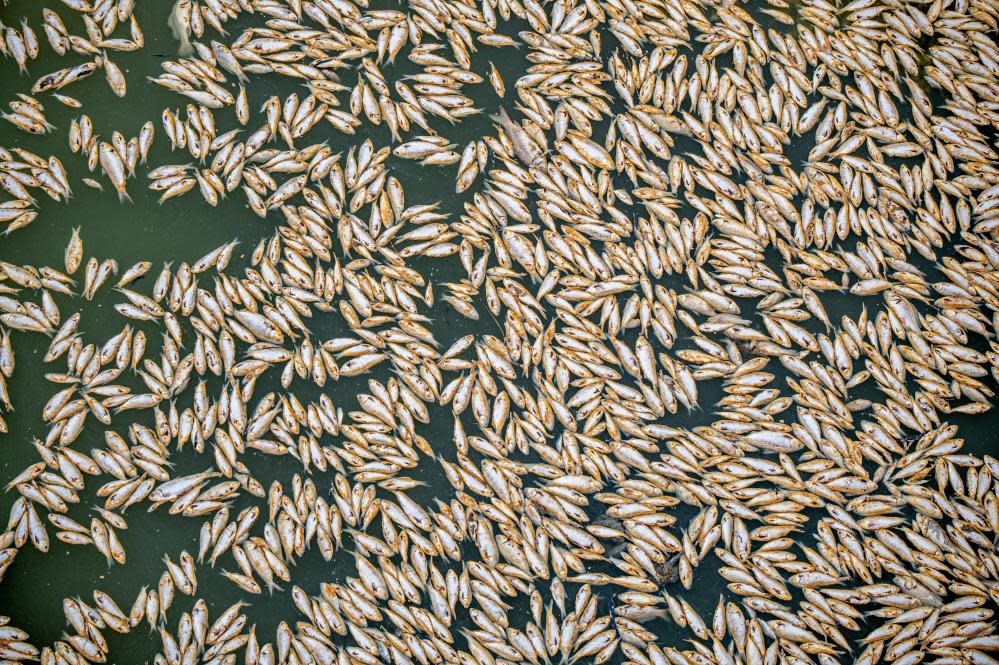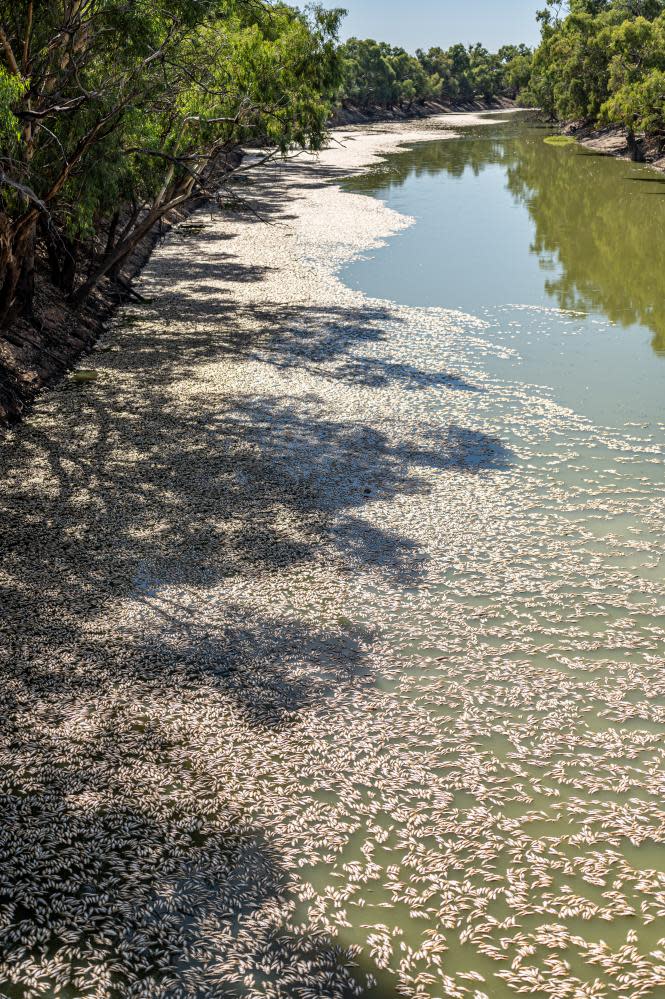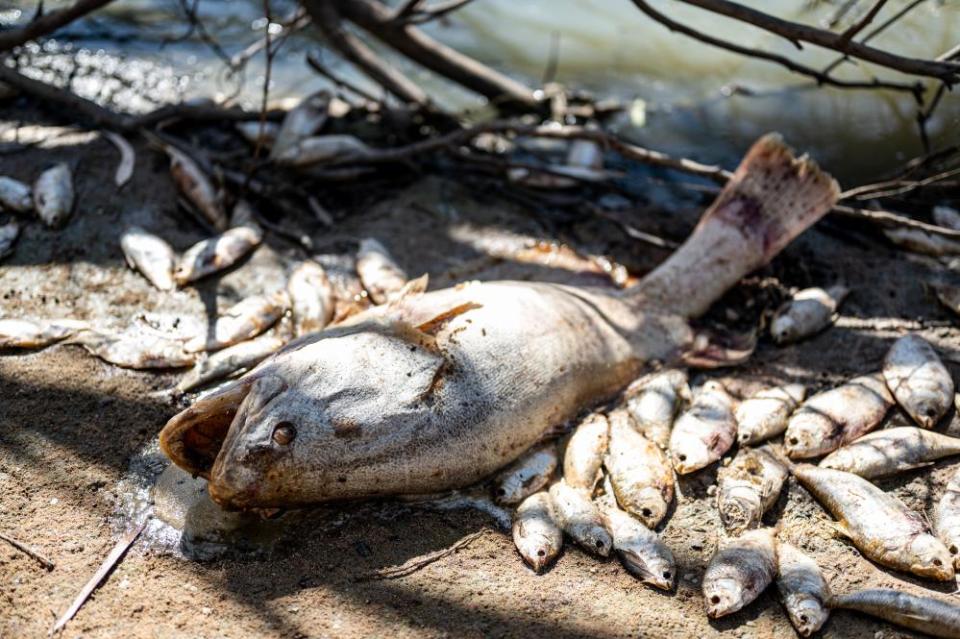Flood and heat: why millions of fish are dying in western NSW

For tens of kilometres, millions of dead fish are floating in slicks along parts of the upper Darling-Baaka River, turning the water green and leaving a putrid smell around the small New South Wales town of Menindee.
The scenes come just four years after the area witnessed a series of mass fish kills with millions of native fish perishing, prompting an independent inquiry.
So what’s behind this current event? How and why did it happen, and could anything be done to stop it happening again?
What happened?
On Friday, locals in Menindee reported seeing millions of dead fish in the river. State government authorities confirmed an unfolding fish-kill event.
Most of the fish affected are bony bream, but other natives caught up in the carnage include Murray cod, golden perch, silver perch and the invasive European carp.
Sign up for Guardian Australia’s free morning and afternoon email newsletters for your daily news roundup
Authorities and locals have said the current event has seen more fish die than in the previous mass fish kills in the summer of 2018-19.
The investigation by authorities includes toxicology and pesticide tests, but there is broad agreement the deaths were probably related to a drop in oxygen levels in the water.
Experts have said it’s likely a series of events has caused the fish deaths.
Related: I’ve watched the Murray-Darling for 30 years and I’ve never seen carp numbers like this
The region experienced major flooding in January, after three relatively wet years.
Soil and vegetation would have been washed into the river, causing bacteria and micro-organisms to grow – this uses up oxygen.
In recent days, heatwave conditions have swept across the area with temperatures above 40C. Warmer water holds less oxygen, worsening conditions.
Where did all the fish come from?
For there to be a mass fish death, there needs to be masses of fish.
The wet conditions over the past three years have given native fish a chance to reproduce. The flooding in January meant more water in the river and even more chance to breed.
“There’s a good few years of fish and they will have been hanging out for quite some time in the channels and lakes. The biomass has been building for a couple of years,” says Prof Fran Sheldon, of Griffith University’s Australian Rivers Institute.
“Bony bream are the kind of fish that you think will die just when you look at them. They’re not particularly tolerant to low oxygen. But they breed really rapidly and they’ll have grown in massive numbers.”
The bream are known for their “boom and bust” cycles that respond to the conditions in the river.

Sheldon says even without the heatwave, it is likely some of the bream would have perished because there would not have been enough food in the river to sustain that many fish.
But critically, Sheldon says the bream tend not to move large distances so – unlike other native species like the cod and perch – they will not have been able to swim away to better parts of the river as oxygen levels dropped.
Once the fish start to die, the decomposition further pulls oxygen from the water, exacerbating the problem.
What is being done?
Late on Saturday, the NSW police set up an emergency operations centre in the town to co-ordinate work by state government departments, Water NSW and the Central Darling Shire Council.
Assistant Commissioner Brett Greentree, overseeing the centre, said on Monday they were speaking to contractors to physically remove “as many of the dead fish as possible”. Some of these contractors were also used to remove fish in 2018 and 2019.
Nets would be used to remove the fish, which would be trucked to a landfill site for burial.
The river is a key water supply for the town and Greentree said water from a treatment plant was still of “high quality”.
But he said water would be trucked in for those people who usually drew water direct from the river.
Contractors were still en route to the area. But Sheldon said in a matter of days the dead fish would probably sink, where they would continue to decompose.
Related: Drought and flooding rains: the Murray-Darling Basin water rights balancing act
A spokesperson for the NSW Department of Planning and Environment said water had been released from Lake Pamamaroo after tests showed oxygen levels downstream of Menindee were approaching critical levels. Some large-bodied fish – such as golden perch – were dead or dying.
The spokesperson said: “Our early readings indicate the [dissolved oxygen] levels have significantly improved and we believe many fish have been saved as a result.
“We are very aware of the importance of balancing water releases to improve environmental outcomes while also maximising water storage ahead of any future drought.”
What else could be done to help the fish?
Sheldon said: “The dead fish will just decompose or be eaten. The big question is the fish that remain.”
The Darling-Bakka River is part of the sprawling Murray-Darling Basin that covers 14% of Australia.
The basin includes two major rivers – the Murray and Darling – as well as 20 smaller but significant other rivers. The whole system is heavily modified.
Since the sheep farming boom of the 1800s, the catchments have been cleared of vegetation.
As other farmers moved in – including cotton, rice and almonds – more locks and weirs were built to store and use water.

In the northern parts of the basin above Menindee, rainfall that would have flowed down the rivers is extracted under licence from WaterNSW and used for agriculture.
In the coming months, Sheldon said regulators will need to make sure enough of any further rainfall is allowed to flow down the river. The commonwealth could release water held in lakes - so called environmental water – to help fish downstream of Menindee.
Sheldon, a member of the independent panel that investigated the Menindee fish deaths in 2018-19 and 2019, said: “Irrigators will want to grow cotton, but how do you manage the system that allows those fish to breathe a bit. The challenge is doing those two competing things.”
The major uncertainty for those surviving fish is rainfall.
After three years of rain, the Bureau of Meteorology has said there is now a 50/50 chance of an El Niño developing this summer – a key driver of Australia’s climate that means greater risks of extreme temperatures and drought.
Is this a re-run of 2019?
Not quite. The fish kills in the region in late 2018 and early 2019 came after several years of drought-like conditions.
There was less water in the river systemand many long-lived native species like Murray cod became stuck in isolated areas and were unable to escape when temperatures rose, ultimately starving the fish of oxygen.
One slight note of optimism, says Sheldon, should be that the fish deaths this week illustrate – perhaps perversely – that native fish in the river system can still recover their numbers if they have enough water.

 Yahoo News
Yahoo News 
